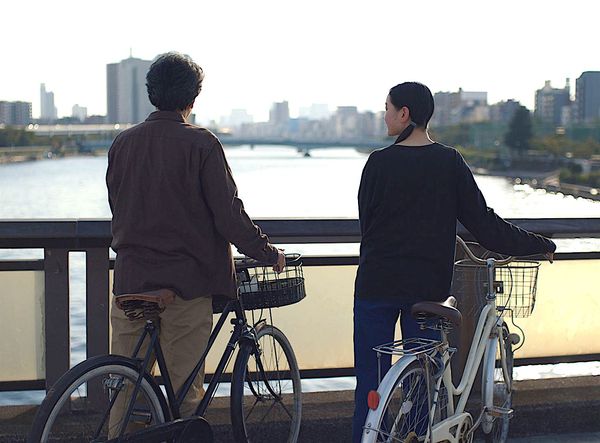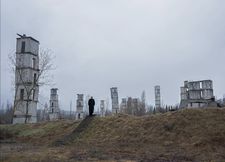On Tuesday, Wim Wenders' Perfect Days (co-written with Takuma Takasaki and starring Cannes Film Festival Best Actor winner Kôji Yakusho) received a Best International Feature Oscar nomination (with Matteo Garrone’s Io Capitano, llker Çatak’s The Teachers’ Lounge, Jonathan Glazer’s The Zone Of Interest, and JA Bayona’s Society Of The Snow). Wenders has three Best Documentary Feature Oscar nominations: (In 2000 Buena Vista Social Club, shared with Ulrich Felsberg, in 2012 Pina, shared with Gian-Piero Ringel, and in 2015 The Salt Of The Earth, co-directed with Juliano Ribeiro Salgado.)
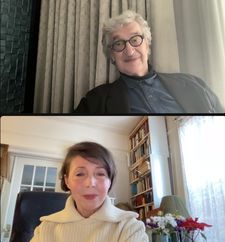 |
| Wim Wenders with Anne-Katrin Titze on using Yasujirō Ozu’s 3:4 format for Perfect Days and Anselm: “I got so much attached to it.” |
In the second instalment with Wim Wenders (the day after he presented Paris, Texas, screenplay by Sam Shepard at the Wim Wenders: An American Cinematheque Retrospective in Los Angeles) we discuss the Yasujirō Ozu format and Cinemascope; TS Eliot’s Little Gidding and returns to the beginning; Joseph Beuys and the power of 3D; a chance re-encounter with Jean-Pierre Melville’s Le Samouraï in Paris, Hirayama, and Alain Delon; Ingeborg Bachmann, the German language and Anselm Kiefer in Anselm (Anselm - Das Rauschen der Zeit); different kinds of loneliness, and how to make a little bag for a tree sapling.
In Perfect Days, the protagonist is Hirayama, played by the extraordinary Kôji Yakusho, who works as a cleaner for The Tokyo Toilet, a public bathroom project launched in 2020, designed by different artists. The terrific soundtrack includes songs sung by Lou Reed, Otis Redding, Patti Smith, Van Morrison, Ray Davies, Mick Jagger, Eric Burdon, and Sachiko Kanenobu.
One of the special bathrooms Hirayama keeps in check has transparent walls in pale orange, metal mauve, and lavender that frost over when someone enters and locks the door. A tourist asks how it works. After his inspections are done, he likes to ride his bike (in an olive poncho when it rains), visit a public bath, eat in a kind of underground food court at a stand where he is a regular, and read Faulkner back home on his Tatami floor and futon before falling asleep. The next day begins with the same sound of sweeping coming in from outside. Wenders has beautiful pacing, things can go a little faster now that we know the routine.
Colleague Takashi (Tokio Emoto) today has a problem. He wants to borrow his older colleague’s car to take out a girl he likes, Aya (Aoi Yamada). Things don’t go exactly as planned and Hirayama introduces Aya to the music of Patti Smith singing Redondo Beach. Following the characters here in their rather mundane adventures to a store that sells and buys cassette tapes or to a used bookshop can be surprisingly exciting to watch because of the rhythm and the wave-like elegance that inhabits the entire movie. The 4:3 format, preferred by Yasujirō Ozu, is the perfect frame for paying attention to the small mysteries that are often overlooked.
From Los Angeles, Wim Wenders joined me on Zoom for an in-depth conversation on Perfect Days and Anselm.
Anne-Katrin Titze: As Anselm is in 3D, I was writing blindly in my notes while watching in the cinema, so I’m not sure if I got the timing right. There’s a quote from Bachmann, “Ich mit der deutschen Sprache/dieser Wolke um mich/die ich halte als Haus…” [I with the German language/this cloud around me/that I hold as a house] and we see Anselm Kiefer dressed in black in a doorway, like Nosferatu. Is that correct?
Wim Wenders: Immediately afterwards. He comes in a little bit like Nosferatu. There’s a whole lot of German elements coming together. This poem by Ingeborg Bachmann is called Exile and it’s a crucial part in the film because she says something in there that Anselm never says in the film but it explains a lot about his work. The lines about the German language and living in the house of the German language. I share that with Anselm, it was always my home and my house, the German language, even if it had been abused and misused for so long.
Part of Anselm’s work is to clean up the German language again and show people that certain German language was strictly abused by the Nazis and had been innocent. Had always been innocent. I mean, the whole 19th century Romanticism had been heavily abused by the Nazis as their language and it wasn’t in any way. So part of Anselm’s work was to free German language of that Nazi burden and that abuse it had undergone.
AKT: By addressing it and letting us rediscover all the layers that language always has. The meanings also, by his paintings with fire.
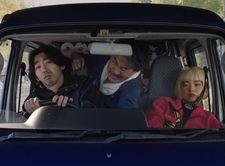 |
| Takashi (Tokio Emoto) driving Aya (Aoi Yamada) with Hirayama (Kôji Yakusho) in the back seat Photo: MASTER MIND Ltd. |
WW: For instance, or with lead or whatever. He used so many techniques or he put his paintings into an oven so they would crash as if they lay in the Sahara desert for 20 years. He does a lot of things to bring time into the equation and his paintings more than any other paintings I know really include time in a very mysterious way. So you stand there and you see time at work.
AKT: That’s beautiful. I think you’re right. Having this film in 3D makes such a difference, because you have a stronger physical reaction, I think. One of the most startling art experiences I’ve had in my life was at the Lenbachhaus in Munich. There was a room by Beuys - Joseph Beuys, Kiefer’s teacher. I walked into that room and I felt history. My body was reacting to something and I understood something about history, about German history, although my brain was lagging behind. In a way it is still lagging behind the experience. We get some of the physicalness of art through the 3D with Anselm, which is amazing.
WW: Yeah, you’re just more there than you’d ever be in front of a flat screen. It is one of the propensities of 3D to allow you to be more there because you use other parts of your brain that are more in the present tense because you have to put the space together. You use parts of your brain to recognise space and form space in your own brain because the screen just shows you an out-of-focus image or two images laid one over the other, and the glasses take them apart again and show you a left eye and a right eye, just like you see in life. And that work of deciphering space heavily uses other portions of your brain that also allow you to be more emotionally involved and more present.
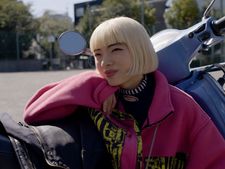 |
| Aya (Aoi Yamada) hears Patti Smith singing Redondo Beach in Hirayama’s (Kôji Yakusho) car Photo: MASTER MIND Ltd. |
That’s why seeing an artwork for real, like your experience with Beuys at the Lenbachhaus - you would have seen pictures of Beuys in the Lenbachhaus, and it would never have touched you. You have to be there in front of it and art does have an aura and 3D allows you to enter into that aura.
AKT: It felt different with Pina, where I got movement and space, while with Anselm I felt space and time and also smell for some reason. Pina did not evoke smell, while Anselm does. A word about the format in Perfect Days - Ozu looms large when you have this format. It’s the perfect one to pay attention to small things everywhere.
WW: Yes, I think it’s totally true. Cinemascope, which is the overriding format these days, I wouldn’t say you’re led to not pay attention, but in Cinemascope you always have to choose where you look. Because if you look at somebody on the left side you don’t know what the person on the right side is doing, it’s too far apart. This 3:4 format which is still the old silent movie format and regular in the Forties and Fifties, it is so much better suited for interiors for instance. For his little room you would never see his futon were it shot in Scope. And the toilets, you’d never see the floor. His work and his attention is so well expressed in that format. I got so used to it, it’s hard to imagine making a film in another format.
Actually both films were in that format. With Anselm I chose it as well because of the size of his works and not many of his works are horizontal, most of them are vertical. If you have a horizontal format like Scope or even widescreen, then all these works - because they are mostly not horizontal - get squeezed in there. So for both films I used that old fashioned 3:4 and I got so much attached to it. And I do think it does create more attention, yes.
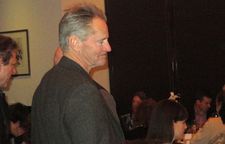 |
| Paris, Texas screenwriter Sam Shepard Photo: Anne Katrin Titze |
AKT: Like the tiny home-made bag that your protagonist uses for the sapling. I love that bag, it’s so beautiful a detail.
WW: That reminds me, I always wanted a folding guide how to fold a piece of newspaper to get that bag. I have to write it down [Wim looks for a pen]. I forgot to ask Kôji [Yakusho]. Because he knew how to do it. I wanted to know how to fold a newspaper to get the little bag and you can always have it with you.
AKT: He made it himself?
WW: Yes, he knew how. I mean that particular one was probably made by the prop department, but he knew how to do it.
AKT: Near the end of the Kiefer film we hear that he is on his way, he is not there yet. I had to think of TS Eliot and Little Gidding and that “The end of all our exploring/ Will be to arrive where we started/ And know the place for the first time.” Do you relate to this with these two films?
WW: Expressed well! With both films in a different way. With Anselm it was to return to his childhood in the end and realise that the man and the child were identical. And that he just succeeded to keep this child alive in himself, which is a big key to his work, I feel. And with Hirayama it is that to live in the here and now is something that we all are perfectly doing when we’re children.
 |
| Kôji Yakusho entering a Tokyo toilet in Perfect Days Photo: MASTER MIND Ltd. |
We don’t know anything else and it slowly in the aging process and the learning process that we start projecting and that we start living in the future. And we start living in the past and we have regrets and we make plans and children only live in the present. And that’s his big lesson to his niece. Come on, start living in the now. Now is now and then is then. I love the little scene when they playfully start chanting it like a mantra. [Wim in a whisper] Now is now.
AKT: Also that he takes something from her. She asks: “Is this your tree friend?” And he says “You’re right, it’s my tree friend.” As though he hadn’t fully understood this before she told him. He’s teachable.
WW: He realises that he must have taught her something when she was a kid and he gave her the camera. And she says, well when I ran away the only thing I knew was I’d come to see you. So he realises he must have had an impression on her when she was a kid.
Somehow it comes back to him. He is taking a picture and she is taking out the same camera and she says, don’t you remember, you gave this to me? So he did leave an impression. That’s why she wanted so much to run away and see her uncle again, because her mom would not have allowed it, because between brother and sister there’s no communication anymore. That’s why he says, we live in different worlds and some of these worlds just don’t connect.
 |
| Anselm Kiefer artwork in Anselm Photo: courtesy of Road Movies |
AKT: Did Alain Delon in Jean-Pierre Melville’s Le Samouraï with his routine ever enter your thoughts for Hirayama’s routine? Waking up and dealing with the bird, in this case his little trees, no?
WW: Maybe unconsciously. It’s very funny, a few months ago, the film [Perfect Days] was already finished and I went to Paris and I was jet-lagged and I left the hotel late, after 10pm or 11o’clock and I walked around the block and I ended up in front of a little movie theatre that I remembered as a student. They had a line in front and it was a late-night show and it was a restored version of Le Samouraï, which I had not seen for 50 years.
AKT: Wow.
WW: It was a big big film for me when I was a film student. It was a giant film for me. I’ve seen it all over and this was like one of my hero films of all times. But I’d never seen it again ever since I was 22, 23. So I walked in and saw the film. It was sold out! 11 o’clock at night the film was sold out.
AKT: Great sign!
WW: I got a place in the first row, which is where I sit anyway. And I so much enjoyed it, a beautiful 4K restoration. It’s tremendous. It is a giant of a film and you’re totally right. I mean, he’s alone and lonely in a very different way than Hirayama. Hirayama knows a lot how to be with people and he loves people and Alain Delon’s character is really lonely and can’t communicate well and is really celebrating his loneliness. And for him his routine is very much a matter of surviving.
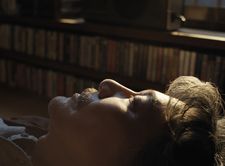 |
| Hirayama (Kôji Yakusho) asleep with his books Photo: MASTER MIND Ltd. |
For Hirayama routine is something else, routine is almost a form of liberty for him. So anyway, I saw Samouraï again and I loved it and everything I was remembering from the film was still there only much better than I had it in mind. It was a glorious experience. I came out of that film and I was so happy that I had left the hotel, not knowing that around the corner I could see the Samouraï.
Read what Wim Wenders had to say on Paul Celan, Anselm Kiefer, fairy tales, Pina and more on Perfect Days and Anselm.
Perfect Days opens in the US on Wednesday, February 7.
The 96th Academy Awards will take place on Sunday, March 10 at the Dolby Theatre in Los Angeles.
Wim Wenders: An American Cinematheque Retrospective runs through Wednesday, February 28.








